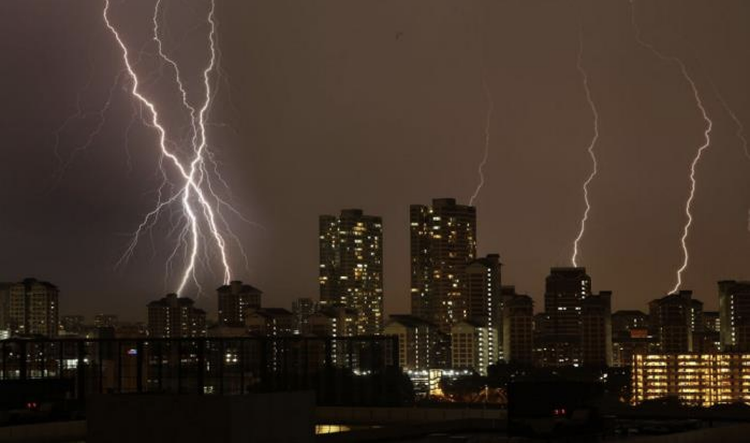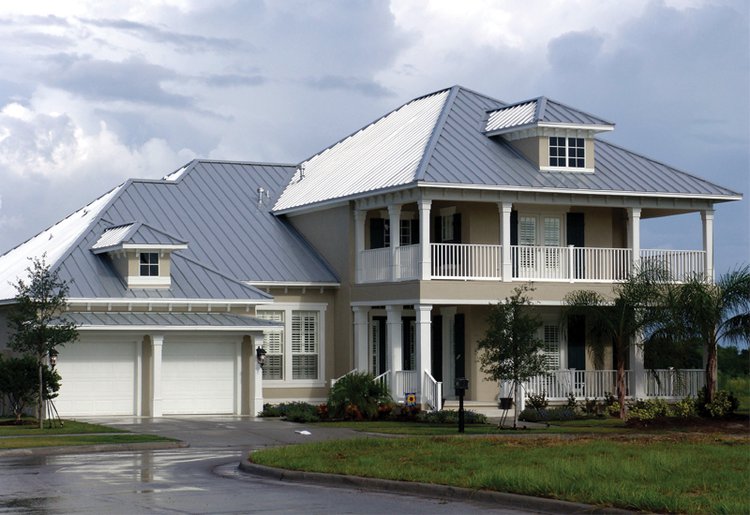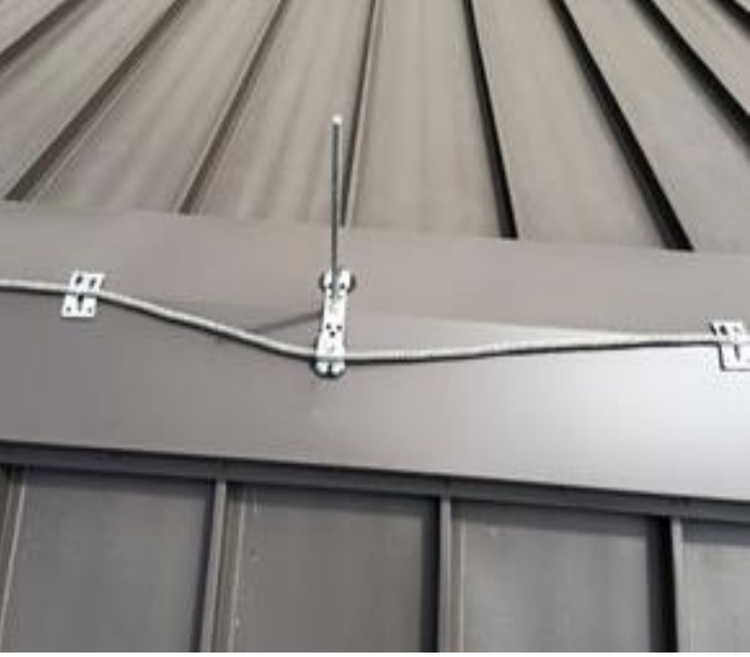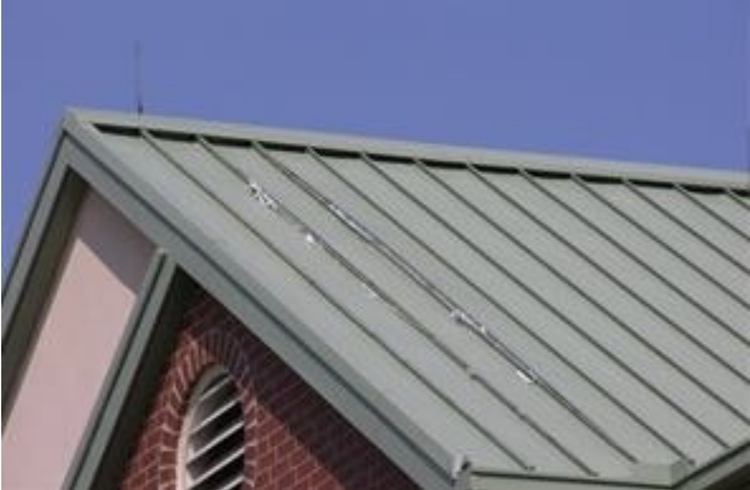
Stay Up to Date on Metal Roofing News and Resources Subscribe

Overview
We live in an electronic age, with computers and other sensitive electronic equipment present not only in every workplace, but also in most households. The element of personal safety notwithstanding, a significant number of people are considering lightning protection for their home or business. When metal roofing is employed on a project, it seems to heighten owner and designer awareness of lightning and there are sometimes questions about whether the use of metallic roofing increases the risk of lightning strike.

Metal Roofing and Lightning Protection: What You Need to Know
Metal roofing doesn't make lightning strikes more likely. Think of lightning as a huge spark of electricity in the sky that sometimes reaches the ground. Using metal for construction doesn't attract lightning, but there are products to protect buildings from lightning damage. These protective products, like lightning rods (also called air terminals or strike termination devices), are typically made of copper or aluminum. It's essential to match the material of the lightning rod with your roofing material (copper with copper or stainless steel roofs) to avoid a type of corrosion. When considering lightning protection, discuss your building's location and materials with a professional installer, following NFPA 780 guidelines.

Air Terminals and Lightning Protection
Air terminals, or just terminals, come in various styles and designs. Traditionally, they are made from at least 3/8" diameter copper or 1/2" diameter aluminum and are at least 10" tall. While other shapes are possible, it's wise to consult a professional before deciding. Terminals are placed at the highest points of a building to intercept lightning strikes before they hit the structure. On larger buildings, multiple terminals are used, including at the roof's edges and midpoints. These terminals are connected to a common lightning conductor lead, usually made of copper or aluminum, with woven wire cabling. This setup provides a direct path for the lightning's current to reach the ground, protecting the building from harm.

Lightning Protection Installation for any Metal Roof
Precise installation is crucial for lightning protection on metal roofs:
- Metal Roof Specifics: Follow unique installation standards for metal roofs, considering weatherproofing and preservation needs.
- Protect Roof Finishes: Prevent damage to painted and metallic coatings during installation. Avoid dragging conductor leads on the roof.
- Secure Attachment: Fasten conductors and air terminals securely to withstand wind and snow. Wind can cause corrosion, while snowpack can damage conductors.
- Snow Retention: In snowy areas, consider snow retention systems to protect conductors. Install them if needed.
- Mechanical Attachment: Use appropriate mechanical methods to attach components, avoiding adhesives, which can fail.
- Roof Types: Metal roofs come in "face-fastened" and "standing seam" types. Follow specific installation guidelines for your roof type.
Proper installation safeguards your metal roof and lightning protection system.

Face-Fastened Metal Roofs
Face-fastened metal roofs are easy to spot with visible, straight rows of fasteners attaching panels to the structure. They're used in various applications over open framing or solid decks.
- When installing a lightning protection system (LPS) on these roofs, ensure:
- Screw fasteners and sealing methods are chosen carefully to maintain durability and prevent water penetration.
- Refer to MCA TB “Fastener Compatibility with Profiled Metal Roof and Wall Panels” for fastener compatibility.
- Attach LPS components through the roof into the structure if possible, but attaching them to metal panels is acceptable with the right fasteners.
- Use butyl co-polymer sealant to attach terminal bases or conductor lead retainer clips to roof panels, protecting them from UV exposure. Avoid relying on exposed sealants on top of assemblies to prevent water infiltration.

Standing Seam Metal Roofs
Standing seam metal roofs are known for minimal exposed fasteners, typically found only at limited locations.
These roofs offer extended warranties and longevity, but penetrating them is prohibited. Non-penetrative seam clamps, anchored every 3 feet along the seams, should be used.
Maintaining independence from the structure, standing seam roofs need non-penetrating seam clamps for air terminals and conductor leads. These clamps, anchored with stainless steel set screws, preserve the roof's coatings.
These guidelines ensure a durable lightning protection system on standing seam metal roofs.

LPS Beneath Metal Roof Surface
Occasionally, the lightning protection system (LPS) is placed beneath roof panels or components like ridge or rake flashing. In this case, the terminal must penetrate the metal roof or flashing.
Use an EPDM rubber boot with an aluminum flange to seal the terminal penetration. Fasten it securely to the roof or ridge cover with appropriate fasteners and sealant, following MCA TB “Fastener Compatibility with Profiled Metal Roof and Wall Panels.”
The rubber boot can be adjusted on-site to snugly fit the penetration, preventing leaks. Ensure the flashing doesn't pin the roof panel to the structure, preserving differential thermal movement. Seal the flashing's base with butyl co-polymer tape.

Myths About Metal Construction and Lightning
Lightning protection systems don't attract lightning; they redirect it safely to the ground. Metal construction doesn't influence where lightning strikes. Proper grounding and lightning protection systems are crucial for buildings with structural steel. Without them, lightning can damage various systems.
Metal siding and roofing can't handle lightning safely; a comprehensive protection system is necessary. Thin metal roofing can't efficiently conduct lightning.
To assess lightning risk, consider strike probability influenced by factors like topography, size, height, and location of the structure.
Evaluate consequences of a lightning strike, including fire and endangerment of lives and property. Metal roofing, being noncombustible, is advantageous during lightning events, reducing risks.

Installation and Choosing a Contractor
Your electrical ground is meant for everyday electricity, not lightning strikes (100 million volts+). Lightning protection is a specialized field with strict standards (NFPA, UL, IEC). It demands professional expertise, not DIY attempts.
Installers must consider various factors, including geography and weather, for proper installation. They should also handle metal roof panels with care to avoid damage. Safety, including adherence to OSHA guidelines, is paramount throughout the process.

Aesthetics
Concerned about how a lightning protection system will look on your structure? Hiring an LPI-certified professional ensures both safety and aesthetics. When installed correctly, these systems are discreet, barely noticeable. Following guidelines guarantees attention to detail for all structures and roof types.
For metal roofing, use aluminum terminals and conductors for steel, zinc, or aluminum roofs, irrespective of coatings. Avoid copper components as they can lead to corrosion issues, especially with coated steel, zinc, or aluminum roofing. Refer to the Metal Construction Association's guidelines for further details.

Maintenance
Maintenance of lightning protection systems is crucial, including secure connections and electrical continuity. Third-party inspection services like UL Master Label Certification and LPI Inspection Program Certification confirm compliance with national safety standards. Regular re-inspections, typically every three to five years, ensure system integrity and up-to-date standards.